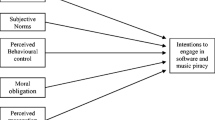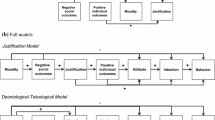Abstract
Moral issues have been included in the studies of consumer misbehavior research, but little is known about the joint moderating effect of moral intensity and moral judgment on the consumer’s use intention of pirated software. This study aims to understand the consumer’s use intention of pirated software in Taiwan based on the theory of planned behavior (TPB) proposed by Ajzen (Organizational Behavior and Human Decision Processes, 50, 179, 1991). In addition, moral intensity and moral judgment are adopted as a joint moderator to examine their combined influence on the proposed research framework. The results obtained from this Taiwan case reveal that the antecedent constructs proposed in the TPB model–an individual’s attitude and subjective norms toward using pirated software, and perceived behavioral control to use pirated software–indeed have positive impacts on the consumer’s use intention of pirated software. In addition, the joint moderating effect of moral intensity and moral judgment is manifested in the consumer’s use intention of pirated software. The results of this study not only could substantiate the results of consumer misbehavior research, but also could provide some managerial suggestions for Taiwanese government authorities concerned and the related software industries devoted to fighting pirated software.
Similar content being viewed by others
References
Ajzen, I.: 1985, ‹From Intentions to Actions: A Theory of Planned Behavior’, in J. Kuhland and J. Beckman (eds.), Action-Control: From Cognitions to Behavior Heidelberg (Springer, Heidelberg).
Ajzen, I. (1991). The Theory of Planned Behavior. Organizational Behavior and Human Decision Processes, 50, 179–211. doi:10.1016/0749-5978(91)90020-T.
Akaah, I.P. (1989). Differences in Research Ethics Judgments between Male and Female Marketing Professionals. Journal of Business Ethics, 8, 375–381. doi:10.1007/BF00381729.
Anderson, J.C., & Gerbing, D.W. (1988). Structural Equation Modeling in Practice: A Review and Recommended Two-Step Approach. Psychological Bulletin, 103, 411–423. doi:10.1037/0033-2909.103.3.411.
Baron, R.M., & Kenny, D.A. (1986). The Moderator-mediator Variable Distinction in Social Psychological Research: Conceptual, Strategic, and Statistical Consideration. Journal of Personality and Social Psychology, 51, 1173–1182. doi:10.1037/0022-3514.51.6.1173.
Beck, J., & Ajzen, I. (1991). Predicting Dishonest Actions Using the Theory of Planned Behavior. Journal of Research in Personality, 25, 285–301. doi:10.1016/0092-6566(91)90021-H.
Bommer, M., Clarence, G., Gravander, J., & Tuttle, M. (1987). A Behavioral Model of Ethical and Unethical Decision Making. Journal of Business Ethics, 6, 265–280. doi:10.1007/BF00382936.
Business Software Alliances (BSA): 2007, The Fifth Annual BSA and IDC Global Software Piracy Study. http://w3.bsa.org/globalstudy/. Accessed 19 Jan 2009.
Carmines, E., & McIver, J.1981. ‹Analyzing Models with Unobserved Variables: Analysis of Covariance Structures’, in G. W. Bohrnstedt and E. F. Borgatta, (eds.), Social Measurement–Current Issues, Beverly Hills: Sage Publications, Inc.
Champoux, J.E., & Peters, W. (1987). Form, Effect Size and Power in Moderated Regression Analysis. Journal of Occupational Psychology, 60, 243–255.
Chang, M.K. (1998). Predicting Unethical Behavior: A Comparison of the Theory of Planned Behavior. Journal of Business Ethics, 17, 1828–1834. doi:10.1023/A:1005721401993.
Christensen, A., & Eining, M. (1991). Factors Influencing Software Piracy: Implications for Accountants. Journal of Information Systems, 5, 67–80.
Cronbach, L.J. (1951). Coefficient Alpha and the Internal Structure of Tests. Psychometrika, 16, 297–334. doi:10.1007/BF02310555.
d’Astous, A., F. Colbert and D. Montpetit: 2005, ‹Music Piracy on the Web–How Effective Are Anti-Piracy Arguments? Evidence from the Theory of Planned Behaviour’, Journal of Consumer Policy 28, 289-310.
Davis, M. A., N. B. Johnson and D. G. Ohmer: 1998, ‹Issue-Contingent Effects on Ethical Decision-Making: A Cross-Cultural Comparison’, Journal of Business Ethics 17, 373-389.
Eagly, A. H. and S. Chaiken: 1993, The Psychology of Attitudes, (Fort Worth, Harcourt Brace Jovanovich, TX).
Eining, M. M. and A. L. Christensen: 1991, ‹A Psychosocial Model of Software Piracy: The Development and Test of a Model’, in R. Dejoie, G. Fowler and D. Paradice (eds.), Ethical Issues in Information Systems (Boyd Boston Fraser Publishing Company, Massachusetts), pp. 182–188.
Fishbein, M. and I. Ajzen: 1975, Belief, Attitude, Intention and Behavior: An Introduction to Theory and Research, (Addison Wseley, Ma).
Fornell, C. and D. F. Larcker: 1981, ‹Structural Equation Models with Unobservable Variables and Measurement Error’, Journal of Marketing Research 18, 39-50.
Franke, G. R., D. F. Crown and D. F. Spake: 1997, ‹Gender Differences in Ethical Perceptions of Business Practices: A Social Role Theory Perspective’, Journal of Applied Psychology 82, 920-934.
Gifford, J. B. and D. G. Norris: 1987, ‹Research Note: Ethical Attitudes of Retail Store Managers: A Longitudinal Analysis’, Journal of Retailing 63, 298-311.
Glover, S. H., M. A. Bumpus, J. E. Logan and J. R. Ciesla: 1997, ‹Re-Examining the Influence of Individual Values on Ethical Decision Making’, Journal of Business Ethics 16, 1319-1329.
Gopal. R. and G. Sanders: 1997, ‹Preventive and Deterrent Controls for Software Piracy’, Journal of Management Information Systems. 13, 29-47.
Harrington, S. J.: 1997, ‹A Test of a Person-Issue Contingent Model of Ethical Decision Making in Organizations’, Journal of Business Ethics 16, 927-939.
Hunt, S. D. and S. M. Vitell: 1986, ‹A General Theory of Making Ethics’, Journal of Macromarketing 6, 5-16.
Jacobson, H. and R. Green: 2002, ‹Computer Crimes’, American Criminal Law Review 39, 73-325.
Jones, T. M.: 1991, ‹Ethical Decision Making by Individuals in Organizations: An Issue-Contingent Model’, The Academy of Management Review 16, 366-395.
Jones, T. M. and V. L. Huber: 1992, Issue Contingency in Ethical Decision Making. International Association for Business and Society Proceeding, pp. 156–166.
Kini, R. B., H. V. Ramakrishna and B. S. Vijayaraman: 2004, ‹Shaping of Moral Intensity Regarding Software Piracy: A Comparison between Thailand and U.S. Students’, Journal of Business Ethics 49, 91-104.
Kini, R. B., H. V. Rominger and B. S. Vijayaraman: 2000, ‹An Empirical Study of Software Piracy and Moral Intensity among University Students’, The Journal of Computer Information Systems 40, 62-72.
Kleinbaum, D. G., L. L. Kupper, K. E. Muller and A. Nizam: 1998, Applied Regression Analysis and Other Multivariable Methods, (Duxberry Press, Pacific Grove, CA).
Kuo, F. Y. and M. H. Hsu: 2001, ‹Development and Validation of Ethical Computer Self-Efficacy Measure: The Case of Softlifting’, Journal of Business Ethics 32, 299-315.
Kwong, K. K., O. H. M. Yau, J. S. Y. Lee, L. Y. M. Sin and A. C. B. Tse: 2003, ‹The Effects of Attitudinal and Demographic Factors on Intention to Buy Pirated CDs: The Case of Chinese Consumers’, Journal of Business Ethics 47, 223-235.
Loch, K.D. and S. Conger: 1996, ‹Evaluating Ethical Decision Making and Computer Use’, Communications of the ACM 39, 74-83.
Logsdon, J. M., J. K. Thompson and R. A. Reid: 1994, ‹Software Piracy: Is It Related to Level of Moral Judgment’, Journal of Business Ethics 13, 849-857.
Marcoulides, G. A. and R. E. Schumacker: 1996, Advanced Structural Equation Modeling, (Erlbaum, Mahwah, New Jersey).
Morris, S. A. and R. A. McDonald: 1995, ‹The Role of Moral Intensity in Moral Judgments: An Empirical Investigation’, Journal of Business Ethics 14, 715-726.
Peace, G. A., D. F. Galletta and J. Y. L. Thong: 2003, ‹Software Piracy in the Workplace: A Model and Empirical Test’, Journal of Information Management Systems 20, 153-177.
Ramakrishna, H. V., R. B. Kini and B. S. Vijayaraman: 2001, ‹Shaping of Moral Intensity Regarding Software Piracy in University Students: Immediate Community Effects’, The Journal of Computer Information System 41, 47-51.
Randall, D. M.: 1989, ‹Taking Stock: Can the Theory of Reasoned Action Explain Unethical Conduct?’, Journal of Business Ethics 8, 873-882.
Randall, D. M. and A. M. Gibson: 1990, Methodology in Business Ethics: A Review and Critical Assessment. Journal of Business Ethics 9, 457-471.
Reidenbach, R. E. and D. P. Robin: 1990, ‹Toward the Development of A Multidimensional Scale for Improving Evaluations of Business Ethics’, Journal of Business Ethics 9, 639-653.
Rest, J. R.: 1979, Development in Judgment Moral Issues, Minneapolis, (University of Minnesota Press, MN).
Rest, J. R.: 1986, Moral Development: Advances in Research and Theory, (Praeger, New York, NY).
Robin, D. P., R. E. Reidenbach and P. J. Forrest: 1996, ‹The Perceived Importance of an Ethical Issue as an Influence on the Ethical Decision-Making of ad managers’, Journal of Business Research 35, 17-28.
SAS Institute Inc.: 1999, SAS/STAT User’s Guide, Version 8, Cary, (NC: SAS Institute Inc.).
Singer, M. S.: 1996, ‹The Role of Moral Intensity and Fairness Perception in Judgments of Ethicality: A Comparison of Managerial Professionals and the General Public’, Journal of Business Ethics 15, 469-474.
Singer, M. S. and A. F. Singer: 1997, ‹Observer Judgments about Moral Agents’ Ethical Decisions: The Role of Scope of Justice and Moral Intensity’, Journal of Business Ethics 16, 473-484.
Singhapakdi, A., S. J. Vitell and G. R. Franke: 1999, ‹Antecedents, Consequences and Mediating Effects of Perceived Moral Intensity and Personal Moral Philosophies’, Journal of Academy of Marketing Science 27, 19-35.
Southwood, K. E.: 1978, ‹Substantive Theory and Statistical Interaction: Five Models’, American Journal of Sociology 83, 1154-1203.
Tan, B.: 2002, ‹Understanding Consumer Ethical Decision Making with Respect to Purchase of Pirated Software’, The Journal of Consumer Marketing 19, 96-111.
Taylor S. and P. A. Todd: 1995, Understanding Information Technology Usage: A Test of Competing Models. Information Systems Research 6, 144-176.
Tonglet, M.: 2002, ‹Consumer Misbehavior: An Exploratory Study of Shoplifting’, Journal of Consumer Behavior 1, 336-354.
Trevino, L. K., C. D. Sutton and R. Woodman.: 1985, Effects of Reinforcement Contingencies and Cognitive Moral Development on Ethical Decision-Making Behavior. Paper Presented at the Annual Meeting of the Academy of Management, San Diego, CA.
Villazon, C. H. and P. Dion: 2004, ‹Software Piracy: A Study of Formative Factors’, Journal of Applied Management and Entrepreneurship 9, 66-85.
Vitell, S. J. and D. L. Davis: 1990. ‹Ethical Beliefs of MIS Professionals: The Frequency and Opportunity for Unethical Behavior’, Journal of Business Ethics 9, 67-70.
Weber, J.: 1993. Assessing the Role of the Moral Issue and Its Intensity upon Managerial Decision Making. International Association for Business and Society Proceedings, pp. 390–394.
Author information
Authors and Affiliations
Corresponding author
Rights and permissions
About this article
Cite this article
Chen, MF., Pan, CT. & Pan, MC. The Joint Moderating Impact of Moral Intensity and Moral Judgment on Consumer’s Use Intention of Pirated Software. J Bus Ethics 90, 361–373 (2009). https://doi.org/10.1007/s10551-009-0046-8
Received:
Accepted:
Published:
Issue Date:
DOI: https://doi.org/10.1007/s10551-009-0046-8




